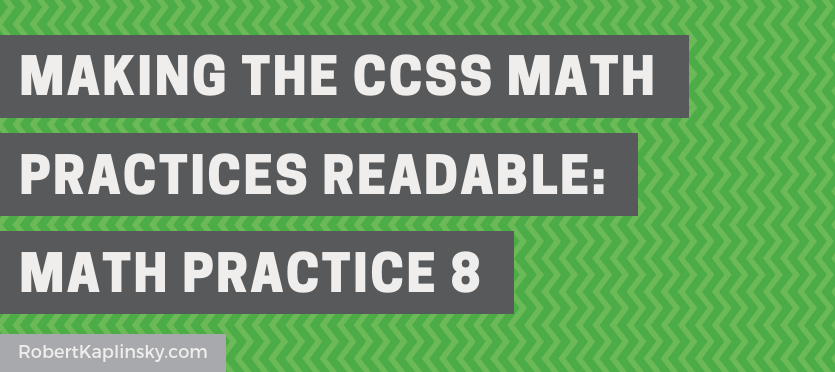This is the eighth of an eight blog post series where I’ll attempt to make a version of each of the Common Core State Standards’ Math Practices that educators, parents, and students can all understand. Simply put, the Math Practices are really tough to make sense of, which means that few educators have read them in full paragraph form and even fewer confidently understand them.
- My guiding principle comes from Antoine de Saint Exupéry who said “perfection is attained not when there is nothing more to add, but when there is nothing more to remove.” Certainly I could always add more details, but my goal is to make each standard as succinct as realistically possible and stop.
- I will make significant changes while still preserving what I believe to be each standard’s essence.
- I’ll also copy and paste the official math practice for comparison.
- I’ll add notes to explain my reasoning.
I realize that inevitably my version will also be flawed. Mainly I’m just curious to see if I can do any better. Thanks in advance for leaving me constructive criticism in the comments below so I can improve them.

Math Practice 8: Simplify problems by noticing patterns.
Mathematically proficient students notice patterns and use them to simplify problems. For example, a student may notice repeated addition and multiply instead or may create a function to represent a repeated operation.
Math Practice 8: Look for and express regularity in repeated reasoning.
athematically proficient students notice if calculations are repeated, and look both for general methods and for shortcuts. Upper elementary students might notice when dividing 25 by 11 that they are repeating the same calculations over and over again, and conclude they have a repeating decimal. By paying attention to the calculation of slope as they repeatedly check whether points are on the line through (1, 2) with slope 3, middle school students might abstract the equation (y – 2)/(x – 1) = 3. Noticing the regularity in the way terms cancel when expanding (x – 1)(x + 1), (x – 1)(x2 + x + 1), and (x – 1)(x3 + x2 + x + 1) might lead them to the general formula for the sum of a geometric series. As they work to solve a problem, mathematically proficient students maintain oversight of the process, while attending to the details. They continually evaluate the reasonableness of their intermediate results.
- I intentionally mirrored some of the language from Math Practice 7 as I see Math Practices 7 and 8 as two sides of the same coin. Math Practice 7 is about breaking things apart and Math Practice 8 is about putting them together.
- I replaced the examples from the actual standard with two shorter examples.


Thanks so much for doing this. I have been working to make the SMP more user friendly for my Teacher Education students. You did a wonderful job!
Awesome! Thanks Becky. So far I haven’t gotten a lot of push back but I’m curious where people think I interpreted them wrong.